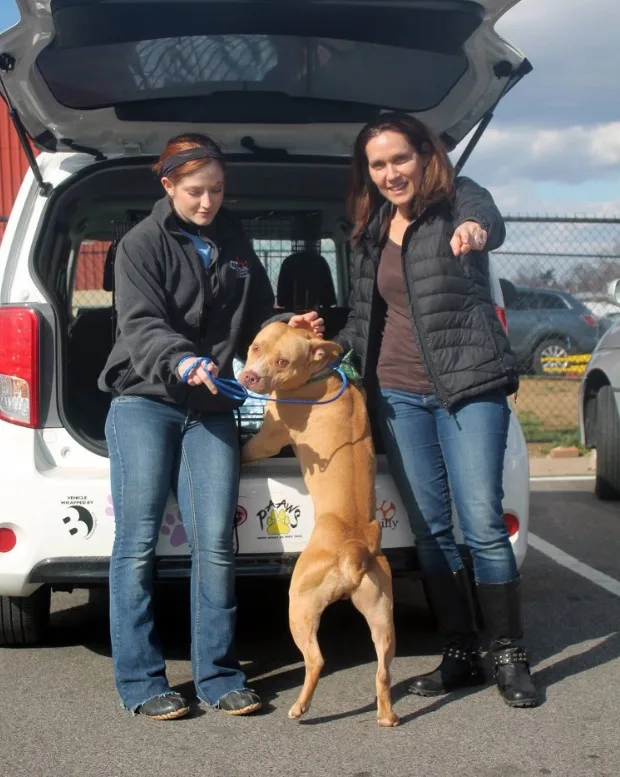It’s a very difficult thing to accept that things are turning out for the worse when you had thought they started getting better, and the hero of today’s story felt exactly that.
March, a Pitbull mix, was the happiest dog ever when he heard that his time at the ACCT Philly was over and a better life was calling out his name.
Unfortunately, his happiness was cut short as his adoption suddenly fell through and he had to be returned back to the Philadelphia city shelter.
Tough Luck

This sudden change of events sure did take a toll on the poor pupper.
As soon as he was brought back to his kennel, he started getting sick and depressed, turning away from the world and confining himself to a gray shelter wall.
However, his luck was about to change.
When a local news reporter, Dawn Timmeney, saw March sad and alone, she knew she had to do something to help.

She took to her Facebook, letting everybody know what an incredible doggo he really is, by writing:
…I’d be a great running buddy. Imagine all the compliments you’ll get when people say, “Where’d you get that great-looking dog?” Bring the family down for a meet-and-greet and who knows … I could be running with you before March turns to April.
The post went viral, and in no time, some great news came.
ACCT Philly posted on their Facebook that March has been saved!
New Beginning

They also clarified that he didn’t really find a forever home, but rather, he was transferred to one of their rescue partners who wanted to stay anonymous.
But, they assured everybody that March is now with a very highly regarded local group that will put him up for adoption through their no-euthanasia shelter.
Hearing the news, March was filled with joy. He was super happy and excited to start his new life full of love, cuddles, and belly rubs.
Not only was this great news for March, but for the shelter, too. They now have an empty kennel that will serve as a temporary home for another animal in need.
Final Word
According to the research done by the ASPCA, approximately 3.1 million dogs across the U.S. enter a shelter every year.
Keeping this in mind, shelters need all the space and helping paws they can get. So please, head down to your local shelter and bring a heartwarming smile to the dogs in need by adopting them or simply keeping them company until they find their forever home.
If you’ve ever noticed your furry friend whimpering, you know how concerning it can be. Dogs communicate through various sounds and behaviors, and whimpering is one way they express themselves. Understanding why your dog is whimpering can help you address their needs and ensure their well-being. As an experienced dog trainer, I’ve encountered this behavior countless times, and I’m here to shed some light on the possible reasons behind your dog’s whimpering.
When your dog starts whimpering, it’s essential to pay attention to their body language and the context of the situation. Dogs may whimper due to pain, anxiety, fear, or even excitement. Each dog is unique, and the reasons for their whimpering can vary. By observing your dog’s behavior and environment, you can start unraveling the mystery behind their vocalizations. In this article, we’ll explore common causes of whimpering in dogs and provide insights to help you decipher what your beloved pet might be trying to tell you.
Understanding Dog Whimpering
The Language of Dogs
Dogs use a variety of sounds and body language to communicate with us. Whimpering is one way your furry friend expresses their emotions, whether it’s joy, pain, fear, or anxiety. Pay attention to their overall demeanor and the context of the situation to better understand what they’re trying to convey.
Decoding the Whimpers
When your dog whimpers, it’s crucial to observe their behavior and surroundings. Whimpering could indicate they’re in discomfort or distress. Check for any signs of physical injury or illness. Additionally, consider any recent changes in their environment that might be causing unease. Remember, each dog is unique, so familiarize yourself with your pet’s specific behaviors to accurately interpret their whimpers.
Common Reasons for Whimpering in Dogs
Hunger or Thirst
If your dog is whimpering, it could be a signal that they’re hungry or thirsty. Just like us, dogs vocalize their needs. Make sure your furry friend has access to food and water to alleviate this cause.
Need for Attention
Dogs are social animals and seek attention from their human companions. Whimpering may be their way of saying, “Hey, notice me!” Spend quality time with your pup, engage in play, or give them a belly rub to address their need for attention.
Discomfort or Pain
Whimpering in dogs can indicate discomfort or pain. Check for any physical injuries or signs of illness that may be causing distress. It’s essential to seek veterinary care if you suspect your dog is in pain to ensure their well-being.
Anxiety and Stress
Anxiety and stress can also trigger whimpering in dogs. Changes in their environment, loud noises, or separation anxiety may contribute to their distress. Create a safe and secure space for your dog, provide reassurance, and consider calming techniques to help ease their anxiety.
Remember, understanding the reasons behind your dog’s whimpering is crucial for their overall happiness and well-being. By addressing their needs promptly and providing comfort and care, you can help your furry companion feel secure and content.
Behavioral and Environmental Triggers
New Environment or Changes at Home
If you’ve recently moved to a new house or made significant changes to your home environment, your dog may be whimpering due to the adjustments. Dogs thrive on routine and familiarity, so unexpected alterations can cause stress and anxiety, leading to whimpering. Ensure your dog has a safe, cozy space to retreat to and gradually introduce them to the new environment to ease their discomfort.
Interactions with Other Animals
When your dog interacts with other animals, especially if they are unfamiliar or if there’s a change in their social dynamics, whimpering can be a common response. Dogs use whimpering as a way to communicate unease or establish boundaries with other animals. Monitor their interactions closely, provide positive reinforcement for good behavior, and intervene if necessary to prevent conflicts that could trigger whimpering.
Health-Related Causes of Whimpering
Warning Signs to Look Out For
If your dog’s whimpering is persistent and is accompanied by other symptoms like lethargy, loss of appetite, vomiting, or diarrhea, it could indicate a more serious underlying health issue. Changes in your dog’s normal behavior, such as increased aggression or reluctance to move, should also not be ignored. These warning signs might mean it’s time to seek professional help.
When to Visit the Vet
When it comes to your furry companion’s health, it’s always better to be safe than sorry. If your dog’s whimpering continues for an extended period, or if you notice any concerning signs, it’s essential to schedule a visit to the veterinarian. They can perform a thorough examination to identify any health issues causing your dog’s discomfort and provide the necessary treatment. Prioritize your dog’s well-being and don’t hesitate to seek expert advice when needed.
Solutions and Comforting Strategies
Providing Basic Needs
Ensuring that your dog’s basic needs are met can help alleviate whimpering. Make sure your furry friend has access to fresh water, a comfortable resting area, and a balanced diet. Providing regular exercise and mental stimulation can also reduce anxiety and restlessness, which are common triggers for whimpering in dogs.
Training and Behavior Modification
Training your dog and implementing behavior modification techniques can address whimpering issues effectively. Positive reinforcement training methods can help discourage unwanted behaviors and promote calmness in your pet. Identifying triggers that cause whimpering and desensitizing your dog to these stimuli through training can significantly reduce this behavior over time.
Professional Help and Therapy
If your dog’s whimpering persists despite your efforts, seeking professional help and therapy may be necessary. A veterinarian or animal behaviorist can assess any underlying medical conditions or behavioral issues contributing to the whimpering. They can recommend specialized treatment plans, medication, or therapy sessions tailored to your dog’s specific needs, promoting overall well-being and comfort.
Remember, addressing your dog’s whimpering promptly and effectively can improve their quality of life and strengthen your bond with them. Your dog’s well-being is essential, so don’t hesitate to seek professional guidance if needed to ensure they live a happy and healthy life.
Conclusion
Understanding why your dog is whimpering is crucial for their well-being. Whether it’s due to pain, anxiety, excitement, or a need for attention, decoding their communication is key. By observing their body language and context, you can better address their discomfort or stress. Health-related issues should not be overlooked, so watch for warning signs and changes in behavior. Meeting your dog’s basic needs, using training techniques, and seeking professional help can make a difference in comforting them. Prioritize your dog’s health and seek guidance when necessary to strengthen the bond between you and your furry friend.
Frequently Asked Questions
What are the different reasons why dogs whimper?
Dogs whimper to communicate pain, anxiety, fear, excitement, hunger, thirst, or a need for attention.
How can I interpret a dog’s whimpering?
To decode whimpering, observe the dog’s body language and consider the situational context. Whimpering may indicate discomfort, pain, anxiety, or stress.
What health issues could be causing my dog to whimper?
Watch for signs like lethargy, loss of appetite, vomiting, or diarrhea, as they could signal a serious underlying health problem.
What should I do if my dog exhibits changes in behavior along with whimpering?
Do not ignore increased aggression or reluctance to move. Seek professional help and monitor closely for any other concerning signs.
[no_toc]

Hey there, I’m Janet Brooks, a dog-loving student from California. I’m all about helping pups in need, especially those without homes. Me and my awesome friends work together to give shelter and love to stray dogs. Oh, and I also write blogs about dogs to share helpful info.